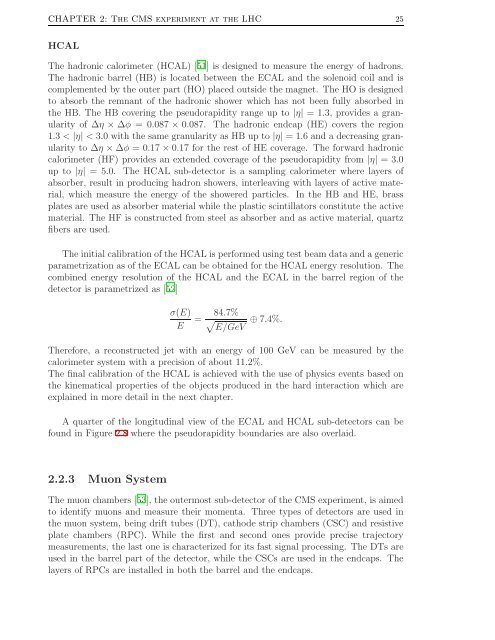Measurement of the Jet Energy Scale in the CMS experiment ... - IIHE
Measurement of the Jet Energy Scale in the CMS experiment ... - IIHE
Measurement of the Jet Energy Scale in the CMS experiment ... - IIHE
Create successful ePaper yourself
Turn your PDF publications into a flip-book with our unique Google optimized e-Paper software.
CHAPTER 2: The <strong>CMS</strong> <strong>experiment</strong> at <strong>the</strong> LHC 25HCALThe hadronic calorimeter (HCAL) [51] is designed to measure <strong>the</strong> energy <strong>of</strong> hadrons.The hadronic barrel (HB) is located between <strong>the</strong> ECAL and <strong>the</strong> solenoid coil and iscomplemented by <strong>the</strong> outer part (HO) placed outside <strong>the</strong> magnet. The HO is designedto absorb <strong>the</strong> remnant <strong>of</strong> <strong>the</strong> hadronic shower which has not been fully absorbed <strong>in</strong><strong>the</strong> HB. The HB cover<strong>in</strong>g <strong>the</strong> pseudorapidity range up to |η| = 1.3, provides a granularity<strong>of</strong> ∆η × ∆φ = 0.087 × 0.087. The hadronic endcap (HE) covers <strong>the</strong> region1.3 < |η| < 3.0 with <strong>the</strong> same granularity as HB up to |η| = 1.6 and a decreas<strong>in</strong>g granularityto ∆η × ∆φ = 0.17 × 0.17 for <strong>the</strong> rest <strong>of</strong> HE coverage. The forward hadroniccalorimeter (HF) provides an extended coverage <strong>of</strong> <strong>the</strong> pseudorapidity from |η| = 3.0up to |η| = 5.0. The HCAL sub-detector is a sampl<strong>in</strong>g calorimeter where layers <strong>of</strong>absorber, result <strong>in</strong> produc<strong>in</strong>g hadron showers, <strong>in</strong>terleav<strong>in</strong>g with layers <strong>of</strong> active material,which measure <strong>the</strong> energy <strong>of</strong> <strong>the</strong> showered particles. In <strong>the</strong> HB and HE, brassplates are used as absorber material while <strong>the</strong> plastic sc<strong>in</strong>tillators constitute <strong>the</strong> activematerial. The HF is constructed from steel as absorber and as active material, quartzfibers are used.The <strong>in</strong>itial calibration <strong>of</strong> <strong>the</strong> HCAL is performed us<strong>in</strong>g test beam data and a genericparametrization as <strong>of</strong> <strong>the</strong> ECAL can be obta<strong>in</strong>ed for <strong>the</strong> HCAL energy resolution. Thecomb<strong>in</strong>ed energy resolution <strong>of</strong> <strong>the</strong> HCAL and <strong>the</strong> ECAL <strong>in</strong> <strong>the</strong> barrel region <strong>of</strong> <strong>the</strong>detector is parametrized as [52]σ(E)E = 84.7% √E/GeV⊕ 7.4%.Therefore, a reconstructed jet with an energy <strong>of</strong> 100 GeV can be measured by <strong>the</strong>calorimeter system with a precision <strong>of</strong> about 11.2%.The f<strong>in</strong>al calibration <strong>of</strong> <strong>the</strong> HCAL is achieved with <strong>the</strong> use <strong>of</strong> physics events based on<strong>the</strong> k<strong>in</strong>ematical properties <strong>of</strong> <strong>the</strong> objects produced <strong>in</strong> <strong>the</strong> hard <strong>in</strong>teraction which areexpla<strong>in</strong>ed <strong>in</strong> more detail <strong>in</strong> <strong>the</strong> next chapter.A quarter <strong>of</strong> <strong>the</strong> longitud<strong>in</strong>al view <strong>of</strong> <strong>the</strong> ECAL and HCAL sub-detectors can befound <strong>in</strong> Figure 2.8 where <strong>the</strong> pseudorapidity boundaries are also overlaid.2.2.3 Muon SystemThe muon chambers [53], <strong>the</strong> outermost sub-detector <strong>of</strong> <strong>the</strong> <strong>CMS</strong> <strong>experiment</strong>, is aimedto identify muons and measure <strong>the</strong>ir momenta. Three types <strong>of</strong> detectors are used <strong>in</strong><strong>the</strong> muon system, be<strong>in</strong>g drift tubes (DT), cathode strip chambers (CSC) and resistiveplate chambers (RPC). While <strong>the</strong> first and second ones provide precise trajectorymeasurements, <strong>the</strong> last one is characterized for its fast signal process<strong>in</strong>g. The DTs areused <strong>in</strong> <strong>the</strong> barrel part <strong>of</strong> <strong>the</strong> detector, while <strong>the</strong> CSCs are used <strong>in</strong> <strong>the</strong> endcaps. Thelayers <strong>of</strong> RPCs are <strong>in</strong>stalled <strong>in</strong> both <strong>the</strong> barrel and <strong>the</strong> endcaps.
















